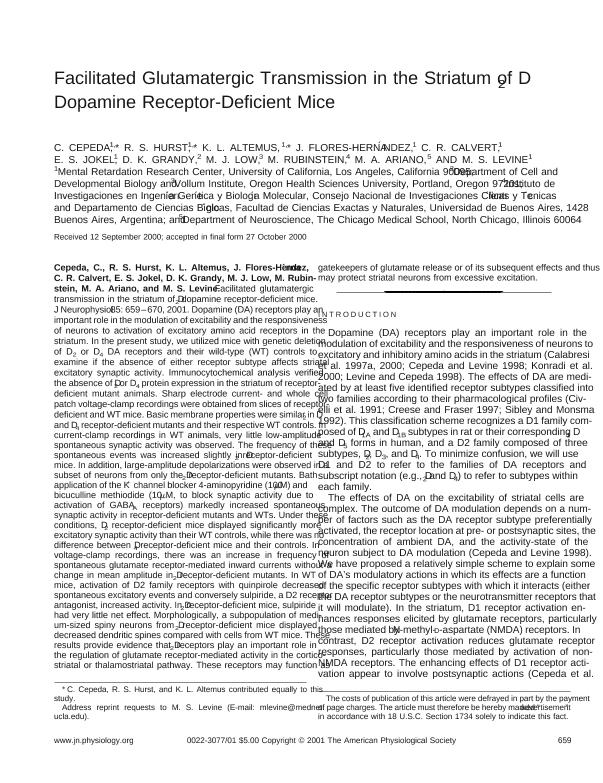Mostrar el registro sencillo del ítem
dc.contributor.author
Cepeda, C.
dc.contributor.author
Hurst, R. S.
dc.contributor.author
Altemus, K. L.
dc.contributor.author
Flores Hernández, J.
dc.contributor.author
Calvert, C. R.
dc.contributor.author
Jokel, E. S.
dc.contributor.author
Grandy, David K.

dc.contributor.author
Low, Malcolm J.

dc.contributor.author
Rubinstein, Marcelo

dc.contributor.author
Ariano, M. A.
dc.contributor.author
Levine, M. S.
dc.date.available
2019-03-15T19:51:10Z
dc.date.issued
2001-02
dc.identifier.citation
Cepeda, C.; Hurst, R. S.; Altemus, K. L.; Flores Hernández, J.; Calvert, C. R.; et al.; Facilitated Glutamatergic Transmission in the Striatum of D 2 Dopamine Receptor-Deficient Mice; American Physiological Society; Journal of Neurophysiology; 85; 2; 2-2001; 659-670
dc.identifier.issn
0022-3077
dc.identifier.uri
http://hdl.handle.net/11336/71785
dc.description.abstract
Dopamine (DA) receptors play an important role in the modulation of excitability and the responsiveness of neurons to activation of excitatory amino acid receptors in the striatum. In the present study, we utilized mice with genetic deletion of D2 or D4 DA receptors and their wild-type (WT) controls to examine if the absence of either receptor subtype affects striatal excitatory synaptic activity. Immunocytochemical analysis verified the absence of D2 or D4 protein expression in the striatum of receptor-deficient mutant animals. Sharp electrode current- and whole cell patch voltage-clamp recordings were obtained from slices of receptor-deficient and WT mice. Basic membrane properties were similar in D2 and D4 receptor-deficient mutants and their respective WT controls. In current-clamp recordings in WT animals, very little low-amplitude spontaneous synaptic activity was observed. The frequency of these spontaneous events was increased slightly in D2 receptor-deficient mice. In addition, large-amplitude depolarizations were observed in a subset of neurons from only the D2 receptor-deficient mutants. Bath application of the K+ channel blocker 4-aminopyridine (100 μM) and bicuculline methiodide (10 μM, to block synaptic activity due to activation of GABAA receptors) markedly increased spontaneous synaptic activity in receptor-deficient mutants and WTs. Under these conditions, D2 receptor-deficient mice displayed significantly more excitatory synaptic activity than their WT controls, while there was no difference between D4receptor-deficient mice and their controls. In voltage-clamp recordings, there was an increase in frequency of spontaneous glutamate receptor-mediated inward currents without a change in mean amplitude in D2 receptor-deficient mutants. In WT mice, activation of D2 family receptors with quinpirole decreased spontaneous excitatory events and conversely sulpiride, a D2 receptor antagonist, increased activity. In D2 receptor-deficient mice, sulpiride had very little net effect. Morphologically, a subpopulation of medium-sized spiny neurons from D2 receptor-deficient mice displayed decreased dendritic spines compared with cells from WT mice. These results provide evidence that D2 receptors play an important role in the regulation of glutamate receptor-mediated activity in the corticostriatal or thalamostriatal pathway. These receptors may function as gatekeepers of glutamate release or of its subsequent effects and thus may protect striatal neurons from excessive excitation.
dc.format
application/pdf
dc.language.iso
eng
dc.publisher
American Physiological Society

dc.rights
info:eu-repo/semantics/openAccess
dc.rights.uri
https://creativecommons.org/licenses/by-nc-sa/2.5/ar/
dc.subject
Dopamina
dc.subject
Corteza Cerebral
dc.subject.classification
Inmunología

dc.subject.classification
Medicina Básica

dc.subject.classification
CIENCIAS MÉDICAS Y DE LA SALUD

dc.title
Facilitated Glutamatergic Transmission in the Striatum of D 2 Dopamine Receptor-Deficient Mice
dc.type
info:eu-repo/semantics/article
dc.type
info:ar-repo/semantics/artículo
dc.type
info:eu-repo/semantics/publishedVersion
dc.date.updated
2019-03-14T14:16:06Z
dc.journal.volume
85
dc.journal.number
2
dc.journal.pagination
659-670
dc.journal.pais
Estados Unidos

dc.journal.ciudad
Bethesda
dc.description.fil
Fil: Cepeda, C.. University of California at Los Angeles; Estados Unidos
dc.description.fil
Fil: Hurst, R. S.. University of California at Los Angeles; Estados Unidos
dc.description.fil
Fil: Altemus, K. L.. University of California at Los Angeles; Estados Unidos
dc.description.fil
Fil: Flores Hernández, J.. University of California at Los Angeles; Estados Unidos
dc.description.fil
Fil: Calvert, C. R.. University of California at Los Angeles; Estados Unidos
dc.description.fil
Fil: Jokel, E. S.. University of California at Los Angeles; Estados Unidos
dc.description.fil
Fil: Grandy, David K.. Oregon Health Sciences University; Estados Unidos
dc.description.fil
Fil: Low, Malcolm J.. Oregon Health Sciences University; Estados Unidos
dc.description.fil
Fil: Rubinstein, Marcelo. Consejo Nacional de Investigaciones Científicas y Técnicas. Instituto de Investigaciones en Ingeniería Genética y Biología Molecular "Dr. Héctor N. Torres"; Argentina
dc.description.fil
Fil: Ariano, M. A.. The Chicago Medical School; Estados Unidos
dc.description.fil
Fil: Levine, M. S.. University of California at Los Angeles; Estados Unidos
dc.journal.title
Journal of Neurophysiology

dc.relation.alternativeid
info:eu-repo/semantics/altIdentifier/doi/http://dx.doi.org/10.1152/jn.2001.85.2.659
dc.relation.alternativeid
info:eu-repo/semantics/altIdentifier/url/https://www.physiology.org/doi/full/10.1152/jn.2001.85.2.659
Archivos asociados
